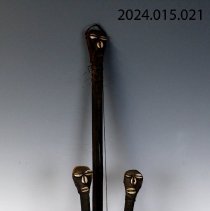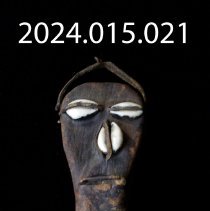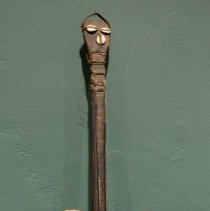Object Record
Images




Metadata
Catalog Number |
2024.015.021 |
Object Name |
Kora |
Description |
This African Kora, or "lute with a gourd sounding box," originates from West Africa. The Mandinka (also known as the Mandingo and Malinke, among other names) are a West African People spread across parts of Guinea, Ivory Coast, Mali, Senegal, the Gambia, and Guinea-Bissau. This lute is built along the lines of a kora, an instrument typically played by men to whom it is passed down through family lines. Its origins are obscure, but it is traditionally associated with royalty, the ruling classes, or religious practices. A kora typically has 21 strings, which are played by plucking with the fingers. It combines features of the lute and harp. In a performance the instrument rests on the group in a vertical position, and the musician plays the instrument while seated. The kora player plucks the strings with the thumb and forefinger of each hand, while the remaining fingers hold two hand posts drilled through the top of the gourd. Possessing a range of just over three octaves, the kora is tuned by moving the leather rings located on the top of the neck. The Gambia River valley is one of the main centers where this instrument is played. Koras are played by musicians mainly to accompany narrations, recitations, and songs in honor of the patron. Special thanks to Dr. Althia Ali for researching this kora alongside Reece Museum staff. This research was made possible by the Luce Foundation. This kora was collected by Mr. C.P. "Bud" Edwards III during his travels to Africa in the 20th century. This artifact was initially donated to the City of Kingsport before it was transferred to the ETSU Reece Museum. |
Artist |
Artist Once Known |
Place of Origin |
West Africa |
Material |
wood, cowrie shells, gourd, string |
Subjects |
Instruments Music African History |
Other Name |
Lute with Gourd Sounding Box |
Search Terms |
Instruments Music African History |
